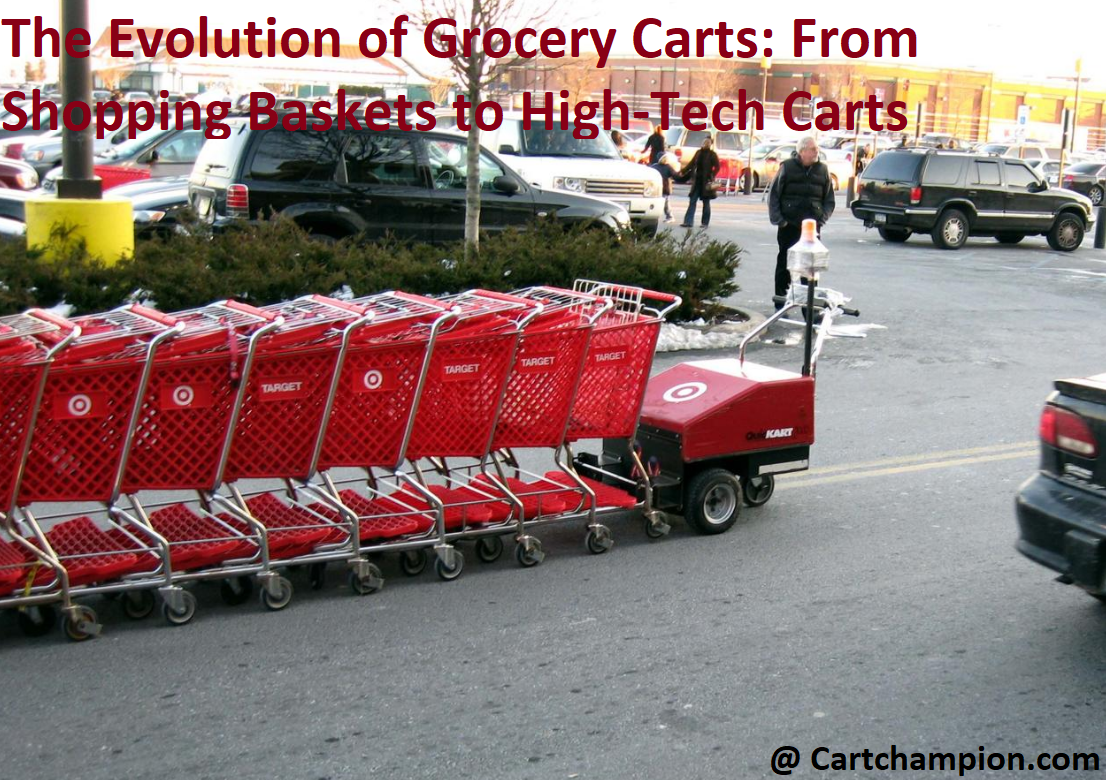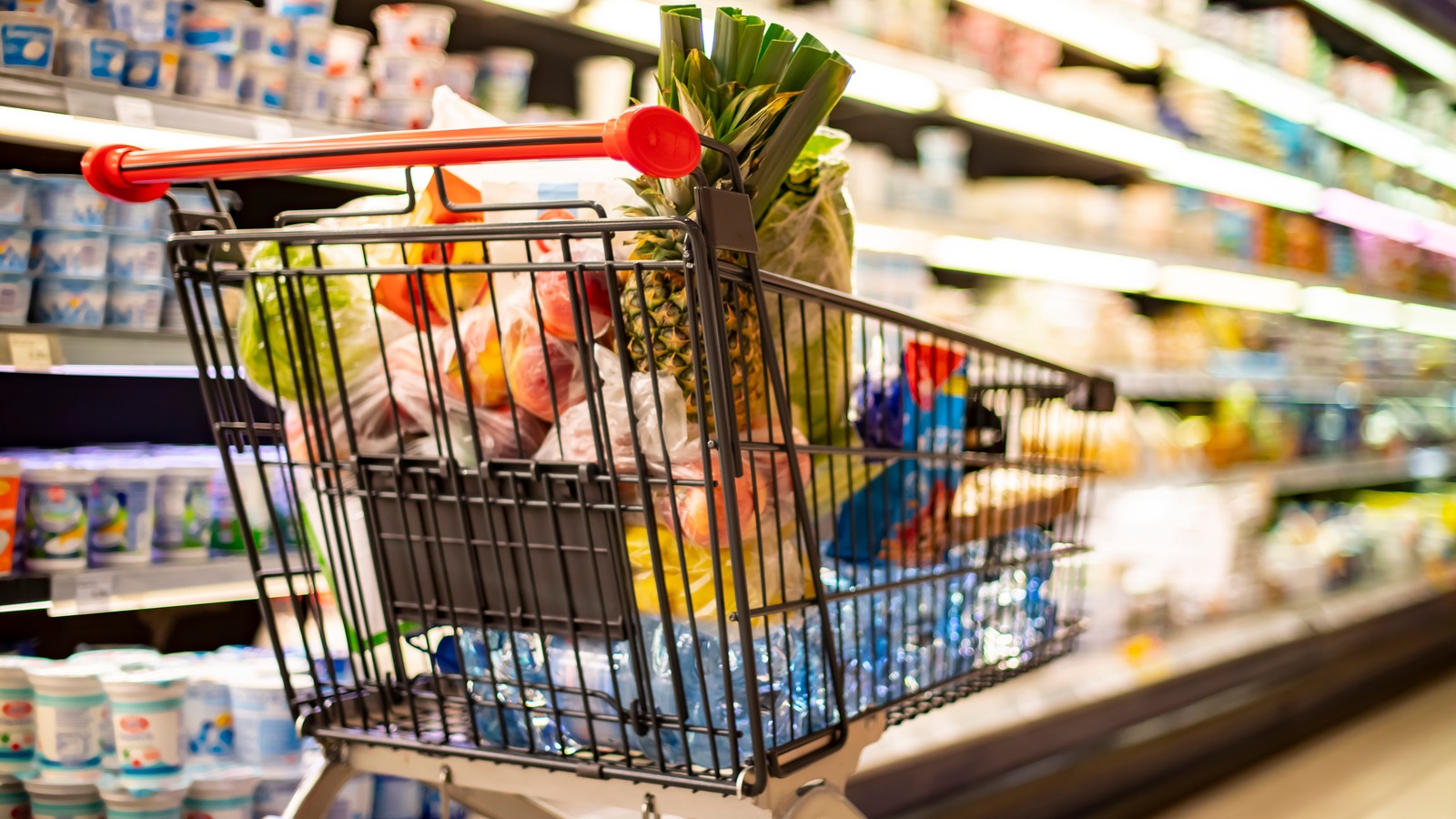Are you struggling with traditional shopping options? Don’t worry! This guide will take you through the advancements in grocery carts and show you how to shop smarter with high-tech solutions.
You’ll discover the many benefits of cutting-edge carts, from their advanced features to improved efficiency.
Grocery shopping has come a long way from its humble origins—gone are the days when customers visited stores with linen-lined shopping baskets in hand, hoping to find fresh produce and other necessities for the week. Now, shoppers are greeted by mostly plastic grocery carts, ranging from classic models to more sophisticated designs. We take a close look at the history and technology of this improved shopping experience in this comprehensive guide to grocery carts.
From their inception in 1937 to their modern-day iterations, supermarket carts have undergone numerous changes. Our goal is to provide readers with a clear overview of these advancements and explore how they have enriched the customer experience in grocery stores across the world. We’ll also examine how supermarkets can benefit from modern cart technology, both economically and environmentally. For a detailed introduction on the evolutionary journey of grocery cart technology, keep reading!
Improvements in Grocery Cart Design
In order to meet the demands of ever-changing shopping environments, retailers have improved their grocery cart designs over time. To reduce the amount of walking a shopper takes while reaching for items on shelves, most stores now offer carts with greater capacity and ergonomic features. These carts typically feature larger wheels, insulated walls and capacity for several shopping bags.
Deep-basket carts are a type of specialty cart that is designed to hold bulk items up to 2 cubic feet in size on each shelf. This type of cart also has an adjustable compartment that can be used to separate different types of items or multiple orders. Other advanced shopping carts are designed with safety methods or built-in technology in mind, such as infrared sensors and tracking systems that assist shoppers with finding specific products.
Today’s well-designed grocery carts are typically made from corrosion-resistant aluminum frames and stainless steel components, giving them a longer lifespan compared to those manufactured in previous years. Push handles have been upgraded with ergonomic designs that offer superior levels of control, comfort and maneuverability for shoppers on the go. And just like supermarket scanners being used at checkout counters, these improved cart designs streamline the entire shopping experience by helping shoppers transport products more efficiently from shelves to checkout lines.

Innovations in grocery cart design over time
Grocery carts are often taken for granted, but their design has transformed over the years to offer shoppers the greatest possible functionality. As each innovation is introduced, grocery stores reap the benefits of improved efficiency and a more satisfying shopping experience for customers. Below is an overview of how grocery carts have evolved over time.
Early days: wicker baskets and canvas bags In 1908, shoppers lugged around wicker baskets and large canvas bags to collect their groceries. These baskets were inconvenient to carry around, awkward to stow away after checkout, and usually did not hold enough items. In 1937, Sylvan Goldman invented the ‘folding basket cart’ which featured wire baskets with handles that could be folded up after use. This design was widely adopted by supermarkets across America during the mid-20th century due to its easy storage capabilities and portability.
Plastic-body carts: ergonomic design with faster checkout times By 1970s and 80s, plastic-body grocery carts were on the rise. These carts could generally hold more items than their predecessors due to their larger size and robust construction; they also featured ergonomic designs that allowed for easier maneuverability down store aisles. Additionally, these plastic body carts sped up checkout times in traditional supermarkets as customers no longer had to empty basket contents onto separate checkout counters before finalizing purchases.
High tech carts: advancing customer convenience In recent years, several grocery chains have invested in wheeled smart trolleys that feature touchscreen tablets for enhanced navigation through stores and automatic billing processes at checkout areas; some even come with features such as reminder lists or product location finders!. Next-generation smart cart models are also equipped with sensors that notify store owners when an item has been removed from its shelf or when an aisle needs restocking – leading to greater operational efficiency within stores.
This modern era of grocery cart design promises new advances in convenience as well as increased operational efficiency – providing an optimal shopping experience for customers while enabling businesses to benefit from automation opportunities at checkout areas and other back-end processes.
Factors driving improvements in cart design
The grocery shopping experience has evolved dramatically over the last few decades as retailers strive to improve customer satisfaction. As one of the key components of a store’s shopping experience, carts have seen tremendous innovation and improvement in recent years. Retailers are looking for ways to reduce costs without sacrificing customer service or convenience. In addition, new regulations, trends and technologies have been developed that drive changes in cart design and structure.
A few factors that have driven improvements in cart design include:
- Cost reduction: Carts are expensive items, so reducing materials through improved design can help reduce operational costs without affecting quality or customer satisfaction.
- Height adjustability: Shopping carts can be too tall for many shoppers, especially those with disabilities and elderly customers. Carts are now designed to accommodate a wider range of heights by allowing users to adjust the height of the carts.
- Ease of use: Improvements such as better ergonomics, ease of carrying groceries and self-locking brakes make it easier for customers to navigate store aisles with their carts.
- Durability: Manufacturers often incorporate heavier duty materials that resist climate conditions such as extreme temperatures and rainstorms. This helps maintain the look and functionality of carts over time despite frequent use by customers.
- Design innovations: Retailers often favor visually appealing designs that feature creative concepts such as handles that have built-in digital displays or bio-metric recognition capabilities to track customer activity within stores.
Examples of grocery cart design improvements
Grocery carts have changed significantly since the 1950s, when a simple metal cart with four small wheels was an innovation. Over the years, designers have worked to make grocery carts more efficient and user-friendly. Today’s grocery cart looks quite different from those of past generations. Here are a few examples of design improvements in today’s grocery carts:
Functional design: Many carts now feature ergonomic handles that are designed for comfort and ease-of-use. The handles can be adjusted to accommodate users of different heights and widths, making it easier for shoppers to push the cart through the store. Additionally, some carts come equipped with cup holders for hands-free beverage transport and flip-up child seats so parents can bring their toddlers along on shopping trips.
Lightweight materials: Today’s lightweight construction materials make store fronts look neat and uncluttered while also providing shoppers with an effortless cart experience. Carts constructed from steel or aluminum are durable yet lightweight so they can easily glide down store aisles while offering superior load capacity compared to traditional baskets or plastic bags.
High Tech features: Some stores offer advanced features like automated checkout or kiosk interfaces that allow customers to purchase items without stepping foot inside the store. This practically frictionless shopping experience is part of a broader trend called “smart retailing” in which stores employ interactive technology to improve customer convenience and satisfaction.
III. High-Tech Grocery Carts
The average grocery cart has come a long way since the past. Today, high-tech carts have made shopping much easier and more efficient for customers. These carts are designed with features that make it easier for customers to store their items and also track their purchases.
High-tech grocery carts come in different shapes and sizes, but all have some common features that make them stand out from the traditional shopping baskets of yesteryear. These include an external scanning device to scan barcodes, a built in payment terminal to pay at the register without needing to remove the items from the cart, an integrated basket so small items can be secured, an internal inventory tracking system to keep track of what customers are buying, and a variety of sensors that measure weight and motion as customers move around the store.
Today’s high-tech grocery carts offer new conveniences such as interactive displays that can help customers find what they need quickly or provide additional information about products they’re considering purchasing. In addition, these carts now feature RFID tags that help retailers manage their stock by providing real time data on their availability and location within the store. Finally, these carts may be equipped with security systems to deter theft or vandalism.
High-tech grocery carts provide many useful features for shoppers and retailers alike. With innovations such as easy checkout options, real time tracking systems, interactive displays and even security measures built into modern designs – there is something for everyone when it comes to taking advantage of these new types of shopping solutions!
Introduction of high-tech grocery carts
Technology continues to change the way we shop. With greater customer demand for convenience, grocery stores have begun introducing high-tech shopping carts. These carts offer features such as checkout scanners, touchscreens, and remote locking capabilities. High-tech grocery carts often increase consumer satisfaction by providing more efficient store operations and customer benefits such as savings and convenience.
High-tech carts have quickly become a popular choice among retailers, offering an array of advantages over traditional shopping carts. This guide will provide an overview of these innovative products and explain how they are revolutionizing grocery stores across the country. Additionally, it will explore the impact these new products have had on the industry and consumers alike.

Features of high-tech grocery carts
High-tech grocery carts offer a wide range of features to help streamline the shopping experience. Some of these features include:
-Integrated Scanners/Tablets: Many high-tech grocery carts feature integrated scanners or tablets that allow customers to quickly scan items they want to purchase. This helps customers save time and easily store items in the cart.
-RFID Technology: Radio frequency identification (RFID) tags are embedded in high-tech grocery carts so stores can keep track of where customers have been and what items they have purchased.
-Smart Display: A large digital display located on the top of the cart helps provide customers with helpful information about products, locations, specials and more.
-Automatic Checkout: With automatic checkout, customers are able to pay for their purchases without ever having to wait in line or manually check out their items. This helps elevate the customer experience by providing a fast and convenient checkout process.
-Integrated Camera Systems: An integrated camera system can be used to view customer’s purchases in real time while they shop. This helps store associates ensure that no wrong item was scanned or no valuable item was left behind during checkout process, increasing operational efficiency at brick & mortar stores significantly.
Advantages and disadvantages of high-tech grocery carts
High-tech grocery carts have revolutionized the way people shop, providing enhanced convenience and, in some cases, improved customer service. Digital shopping aids, like touchscreens and interactive displays, allow customers to find products quickly with minimal effort and make purchases without waiting in line. This technology also provides customers with more detailed product information than was previously available in the store. However, high-tech grocery carts come with their own sets of advantages and disadvantages that need to be taken into account before implementing this type of technology in an organization.
Advantages of High-Tech Grocery Carts:
- Enhanced customer experience: High-tech grocery carts provide customers with a more interactive shopping experience that is tailored to their individual needs and interests.
- Reduce wait times: With digital payment options, customers don’t have to wait in long checkout lines since they can pay quickly and check out via mobile devices instead.
- Improved accuracy: High-tech grocery carts help reduce errors that occur during manual data entry like transcribing wrong prices or misreading expiration dates while scanning items at checkout.
- Increased efficiency: Automation helps increase efficiency by streamlining processes such as inventory tracking or order fulfillment as well as providing real-time insights into customer behavior which can lead to more accurate product placement and better promotional campaigns for higher sales volumes.
5 Greater customer service potential: By incorporating features such as smart shelving or personal assistants (like Alexa), stores are able to offer their customers better service by providing specific product information when needed or suggesting new products based on previous purchasing histories from across the store’s numerous outlets (online stores included).
Disadvantages of High-Tech Grocery Carts:
1 Expense costs : The development and implementation of high tech grocery carts requires a significant investment initially; this cost includes not only the purchase of the cart itself but also any necessary related software or services that may be required for its integration into existing systems within an organization as well as other associated costs (such as additional staff training).
2 Security risks : If not securely monitored, high tech grocery carts can create an array of security risks due to users’ access rights being breached , allowing malicious individuals insight into sensitive information . It is therefore important for organizations implementing these technologies to ensure proper user authentication measures are in place between cart access points to prevent unauthorized access .
The Future of Grocery Carts
As the technological and consumer landscape continues to rapidly evolve, the grocery cart is undergoing changes as well. Supermarkets are exploring more and more creative and innovative ways to improve their customer shopping experience through the use of technology in their carts.
For instance, some stores have begun introducing devices such as orientation sensors that help locate customers’ desired items in a store. Others may implement RFID and barcode scanning systems so customers can quickly add items to their digital cart while they shop. In addition, some supermarkets may incorporate artificial intelligence solutions such as facial recognition software so cashiers can quickly identify shoppers at checkout.
Moreover, many stores now offer automatic checkout options which allow customers to select a payment method right from their cart’s built-in touch screen. Foosball tables or other gaming solutions may even be integrated with grocery carts of the future for increased customer engagement and loyalty points incentives.
As technology continues to progress, many supermarkets are looking for new ideas on how they can leverage it to create a better shopping experience for its customers from start to finish. What you choose should be dependent on what your customer needs are in relation to your marketing plan, budget and goals for improving the shopper experience.
Predictions for the future of grocery carts
Grocery stores are constantly looking for new ways to make the shopping experience easier and less time-consuming. As shoppers move toward self-service checkout options, grocery carts may be the next frontier.
Technology is changing how people shop and evolving grocery carts along with them. In recent years, shopping carts have embraced technology such as RFID tracking chips and Bluetooth scanners to increase convenience and accuracy during checkout. As this trend continues, shoppers may soon find their carts equipped with additional features, including GPS tracking or facial recognition software to verify account credentials or coupons.
Voice command capabilities could be helpful in locating certain products in the store, especially as shelf space becomes increasingly scarce. Non-tech features such as multi-level baskets, automated bagging systems and WiFi-enabled carts would also provide an innovative level of convenience for shoppers navigating large stores filled with a multitude of products.
Not only would these enhancements make for a more efficient shopping experience, but they could also help streamline the checkout process by making it easier for customers keep track of their items and providing invaluable data for retailers that can be used to improve store operations. The possibilities are seemingly endless — time will tell which features make it into mainstream retail markets first!
Possible advancements in grocery cart technology
Grocery carts have come a long way from the traditional shopping basket. The evolution of this technology has opened up a number of possibilities for grocery stores to provide customers with an enhanced shopping experience. There is still much room for improvement and advancement, and here we will explore some possible advancements in grocery cart technology.
One of the most exciting advancements would be the ability to equip groceries carts with interactive displays. These displays could be used to provide customers with real-time information about product availability and relevant promotions. Additionally, these displays could offer customers access to product reviews, safety information, nutritional facts and more. With this capability, users can make smarter decisions while they’re shopping without having to take the time to investigate products individually by themselves.
Another possible advancement is in-cart navigation capabilities similar to GPS systems that are used in cars. This would enable shoppers to quickly locate items on their lists in store aisles with ease, eliminating wasted time spent walking aimlessly in search of specific products. Additionally, this system could also allow stores or suppliers to facilitate real-time advertising or alert shoppers about items on sale as they pass through certain parts of a store or aisle — allowing for even more convenience and personalization throughout their shopping journey.
Finally, there are many potential opportunities for integrating modern advances such as RFID tags and sensors into grocery cart technology that can immediately detect items placed inside the cart and even support automated payment processes upon checkout — streamlining your shopping experience from start-to-finish!
Potential impact of grocery cart advancements on the shopping experience
Shopping carts have seen a dramatic evolution over the past couple of decades. From mechanical to electronic, from static to automated, grocery carts have made it easier for customers to transport items around the store, as well as increased their overall shopping convenience. While this technology has undeniably enhanced the in-store experience for shoppers, there is potential for even bigger gains when it comes to how advancements in shopping cart technology can shape and redefine the entire buying journey.
Advanced shopping cart technologies can leverage consumer data and provide tailored recommendations based on past purchases while helping customers manage inventory levels and make smarter purchasing decisions. It’s not only about making sure customers fill up their carts with lots of goodies; grocery store administrators can also implement strategies that empower shoppers with more information and insights on specific items or categories of food that they may be looking to purchase or try out.
Moreover, introducing certain computer vision components such as optical character recognition (OCR) scanners within the trolleys can recognize products and brands in-store paving way for digital advertising campaigns within physical stores. Not only will the use of digital content help drive sales, but it will also add an extra layer of utilization for stores as a way to engage customers beyond what’s in their baskets.

Conclusion
Grocery carts have come a long way since their introduction in 1937. They have gone from wooden and metal hand-pulled carts, to wire frames and plastic molded carts, to high-tech shopping helpers like electronic carts that confirm product selection, offer coupons, and can pay with the touch of a button.
Not only are they more efficient than ever before and help make the shopping experience easier and more enjoyable for consumers, they also promote better hygiene practices and allow retailers to track shoppers’ buying habits.
As technology continues to evolve, so too will the grocery cart — making it even smarter, faster, stronger… and likely bigger too! And that’s good news all around for shoppers who want a better experience every time they enter their favorite store.
FAQ’S
What is the history of the grocery cart?
The first grocery cart was invented in 1937 by Sylvan Goldman, who owned a grocery store chain in the United States.
What are some of the unique features of the new high tech shopping carts?
Some unique features of new high tech shopping carts include touch screens for ordering and product information, built-in cameras and sensors for tracking inventory, and the ability to pay for purchases through the cart itself.
Which technology is used in smart shopping cart?
Smart shopping carts use a variety of technologies, such as RFID (radio-frequency identification), computer vision, and machine learning algorithms, to enable features such as real-time inventory tracking, personalized recommendations, and automatic checkout.
What is shopping cart technology?
Shopping cart technology refers to the use of various technological innovations, such as sensors, cameras, and algorithms, to improve the shopping experience, increase efficiency, and enhance safety and security.
How has technology changed shopping experience?
Technology has changed the shopping experience in numerous ways, such as enabling online shopping, providing personalized recommendations, streamlining checkout and payment processes, and enhancing in-store experiences through innovations such as augmented reality and smart shopping carts.
How technology changed our shopping experience?
Technology has changed our shopping experience by making it more convenient, efficient, and personalized, as well as by enabling new forms of shopping, such as online and mobile shopping.
Who invented the smart grocery cart?
The concept of the smart grocery cart has been developed by a number of companies and inventors over the years, including Veeve, Caper, and Microsoft.
What is the main purpose of a shopping cart?
The main purpose of a shopping cart is to provide a convenient way for shoppers to transport items as they shop.
Who created the shopping cart theory?
The shopping cart theory is a social experiment that was first popularized by Shannon Proudfoot in a 2017 article for Maclean’s magazine.
What are grocery carts called?
Grocery carts are also commonly known as shopping carts, trolleys, or carriages.
See Also-
- Best bag for push cart 2023
- Best garden cart 2023
- Best beach cart for soft sand 2023
- Best hand cart 2023
- Best yard cart 2023


